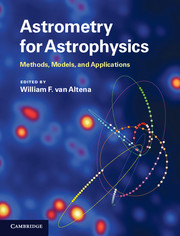Book contents
- Frontmatter
- Contents
- List of contributors
- List of acronyms
- Preface
- Part I Astrometry in the twenty-first century
- 1 Opportunities and challenges for astrometry in the twenty-first century
- 2 Astrometric satellites
- 3 Ground-based opportunities for astrometry
- Part II Foundations of astrometry and celestial mechanics
- Part III Observing through the atmosphere
- Part IV From detected photons to the celestial sphere
- Part V Applications of astrometry to topics in astrophysics
- Index
- References
2 - Astrometric satellites
from Part I - Astrometry in the twenty-first century
Published online by Cambridge University Press: 05 December 2012
- Frontmatter
- Contents
- List of contributors
- List of acronyms
- Preface
- Part I Astrometry in the twenty-first century
- 1 Opportunities and challenges for astrometry in the twenty-first century
- 2 Astrometric satellites
- 3 Ground-based opportunities for astrometry
- Part II Foundations of astrometry and celestial mechanics
- Part III Observing through the atmosphere
- Part IV From detected photons to the celestial sphere
- Part V Applications of astrometry to topics in astrophysics
- Index
- References
Summary
Introduction
The launch of the Hipparcos satellite in 1989 and the Hubble Space Telescope in 1990 revolutionized astrometry. By no means does this imply that not much progress was made in the ground-based techniques used exclusively until then. On the contrary, the 1960s to 1980s saw an intense development of new or highly improved instruments, including photoelectric meridian circles, automated plate measuring machines, and the use of chargecoupled device (CCD) detectors for small-field differential astrometry (for a review of optical astrometry at the time, see Monet 1988). In the radio domain, very long baseline interferometry (VLBI) astrometry already provided an extragalactic reference frame accurate to about 1 milliarcsecond (mas) (Ma et al. 1990). Spectacular improvements were made in terms of accuracy, the faintness of the observed objects, and their numbers. However, there was a widening gulf between small-angle astrometry, where differential techniques could overcome atmospheric effects down to below 1 mas, and large-angle astrometry, where conventional instruments such as meridian circles seemed to have hit a barrier in the underlying systematic errors at about 100 mas. Though very precise, the small-angle measurements were of limited use for the determination of positions and proper motions, due to the lack of suitable reference objects in the small fields, and even for parallaxes the necessary correction for the mean parallax of background stars was highly non-trivial. Linking the optical observations to the accurate VLBI frame also proved extremely difficult.
- Type
- Chapter
- Information
- Astrometry for AstrophysicsMethods, Models, and Applications, pp. 14 - 28Publisher: Cambridge University PressPrint publication year: 2012



